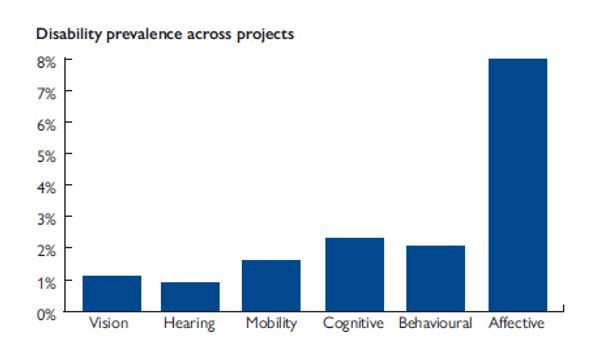Resource Type
Blog
This blog was originally posted on World Vision Stories on November 7, 2022
By Edward Winter, Senior Technical Advisor for Gender Equality and Social Inclusion
The recent ‘Leave No Girls Behind’[1] publication from the FCDO highlighted the issue of invisible disability in education clearly. Nearly 25% of girls (31,550 out of 126,372) supported within Girls’ Education Challenge programs, were identified as having a disability using the child functioning module. Of those, the vast majority had an invisible disability, with less than 2% of children having a mobility disability and just over 1% with a visual disability. The remaining nearly 22% are invisible or less visible. This number also doesn’t count children who may be impacted by reading disabilities such as dyslexia. Part of this number of children impacted by affective disability is related to the impact of COVID-19, higher rates of gender-based violence and unsafe school environments. Girls with disabilities are typically more marginalized than boys with disabilities.

This requires organizations like World Vision to identify ways in which we can do better to assist children with ‘invisible’ disabilities to learn effectively. There are two main ways organizations can do this:
- Making the school environment one where every child can succeed
World Vision has done this is several ways:
- Universal Design for Learning – This year World Vision has worked with CAST, the developer of the universal design for learning guidelines[2] to incorporate these guidelines into the quality assurance tool, World Vision MEQA (meqadata.com), that supports the implementation of our Learning Roots (ECD) and Unlock Literacy (early primary) education programming. This allows children to be motivated, receive information in and express their learning in different ways.
- Making schools safer and more welcoming – World Vision continues to refine its safe and nurturing schools additional project model. The model works with administrators, teachers, school management committees and other community structures and leaders, boys and girls. The goal is that boys and girls can learn in an environment free of gender-based violence and discrimination, safely report issues and receive support and referrals when necessary. The process transforms the attitudes and practices of caregivers, community influencers, students, administrators, and teachers. This model will be integrated into the upcoming Girl Vision Project Model - so watch out for more information coming soon!
- Incorporating life skills and socio-emotional learning support into the curriculum – World Vision has incorporated socio-emotional learning activities within school and community-based activities and learning materials within both Learning Roots and Unlock Literacy Program models. In our youth programming, we are providing essential life skills. Our USAID-funded (USAID Proyecto Puentes) positive youth development program in Guatemala supports over 800 youth with disabilities. We are currently working in a life skills program in Albania to support children with intellectual disabilities to transition to independent living.
2) Linking to child protection structures in communities to provide support and referral services
World Vision recognizes that with large class sizes, it isn’t possible for teachers to know all the children in their class well, so they may not identify children with invisible disabilities or have the ability to meet their needs. For that reason, we seek to build linkages between schools and community-based protection structures in several ways:
- Developing a case management tool for vulnerable children – We have developed a case management system tool that brings together the children, their parents, teachers and other community members to help a child realize their learning and other life goals. Where those goals cannot be met by services in the community, the child and family are referred to other services.
- Using home visitors to support case management - In Mongolia, within the US Dept of State-funded (J/TIP) Child Protection Compact project, World Vision is supporting informal local actors to serve vulnerable children and households through home visitors. Home visitors help identify child and family needs and develop Family Development Plans, provide follow up with psychosocial and parenting support, make linkages and referrals to necessary and locally available medical, social, and economic services, and escalate cases of abuse, exploitation, and neglect to child welfare and protection agencies.
- Linking education and protection services - In emergency contexts the need for effective support through child protection structures can be even more critical. Within World Vision’s Syria response, we have worked with the Jordanian Ministry of Education to support an Early Childhood Development Centre in Azraq camp in Jordan outlined in this article "A glimpse of hope for Syrian children in Jordan’s Azraq Refugee Camp despite prevailing uncertainty". The camp provides access to age- and developmentally appropriate educational and socioemotional learning opportunities for up to 300 children at a time—using participatory curricula which includes art, games, and music activities.
World Vision have acknowledged that the COVID-19 pandemic has affected children as a whole but more importantly to those with hidden and visible disabilities. With this in mind, World Vision has developed a Catch Up Programme to help guide the community as a whole including: caregivers, community and school stakeholders to intentionally include children with hidden and visible disabilities as a natural integration rather than after thought.
For more information on our work, please feel free to contact me for specific gender equality and social inclusion queries: ewinter@worldvision.org or for general education enquiries email: education@wvi.org
